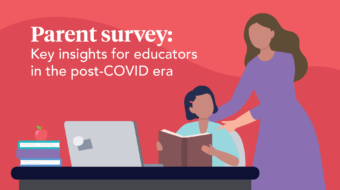
This week, thousands of special education directors, coordinators, teachers and specialists joined Dr. Barry Prizant, a widely recognized, leading expert on classroom behavior management, for the Changing Minds webinar, “Preventing Problem Behavior in Schools: An Emotional Regulation, Relationship-Based Approach.”
To listen to a full recording, click here.
Defining Problem Behavior
Dr. Prizant notes that conventionality and social acceptability are of lesser concern than whether a problem behavior interferes with participation or learning for the student exhibiting the behavior and/or his or her peers. Problem behavior can be either verbal or non-verbal:
Verbal Behavior Examples:
- Repetitive Speech
- Arguing
- Correcting the speaker
- Extreme Language
Non-verbal Behavior Examples:
- Grabbing and/or throwing objects
- Biting
- Hitting
- Kicking
- Scratching
- Self-injurious behavior
Problem behavior is a continuum, and there can be disagreements as to whether behavior is problematic. Ultimately, determining what is problematic needs to be a collaborative, informed, and systematic team process, involving parents.
Problem Behavior: The Reasons Why
More often than not, educators blame students for their actions rather than getting to the root of why they are acting a certain way in the first place. Recognizing the reasons for problem behavior goes a great way toward creating effective ways of dealing with it. For example, a student who acts out when he is tired may have a sleeping disorder, which in turn stems from a lack of bedtime routine at home.
“If you plant lettuce and the lettuce doesn’t grow, don’t blame the lettuce. Look for the reasons why it isn’t doing well
”
Problem behavior needs to be looked at from different perspectives including biological, psychological and social.
Biological factors include sleep deprivation or sleeping issues, nutritional issues, food sensitivities or the inability to control one’s energy (particularly with students who have ADHD, ASD or learning disabilities).
Psychological factors include cognitive and language disabilities. Students who have problems communicating can exhibit problem behaviors because they have difficulty expressing emotions or intentions and then become frustrated. Another psychological factor is negative emotional memory. This is when a student has a negative memory of an activity or subject in school that caused a great deal of stress in the past.
Social factors can be seen when a student enters a busy cafeteria or has to pay attention to too many things at once and becomes overwhelmed by all of the movement and all of the noise.
Once the leading factors of the problem behavior are determined, the team can create ways for the student to either self-regulate or mutually regulate their emotions. Self-regulation is when a student independently participates in an activity such as rocking, pacing or even silence to calm down. Mutual regulation is when the student is provided with supportive social interactions, like going for a walk, to calm down.
Tips for Supporting Emotional Regulation and Preventing Problem Behavior
Dr. Prizant provided the following universal rules to follow when interacting with students who exhibit problem behaviors:
- Set developmentally appropriate expectations
- Reduce stimulation, slow down input and simplify the environment
- Use appropriate interpersonal and learning support
- Prioritize social communication skills
- Build self-determination
- Build executive function (planning and organization) and self-regulatory skills
- Utilize breaks systematically
Just like students, we adults like to take our breaks and do things that keep us on an even keel. Thinking the same way for our students who cannot regulate themselves helps. By first understanding problematic behavior as a consequence of emotional dysregulation, educators and parents can determine ways to bring students back to a regulated state to reap the benefits of the classroom environment.



